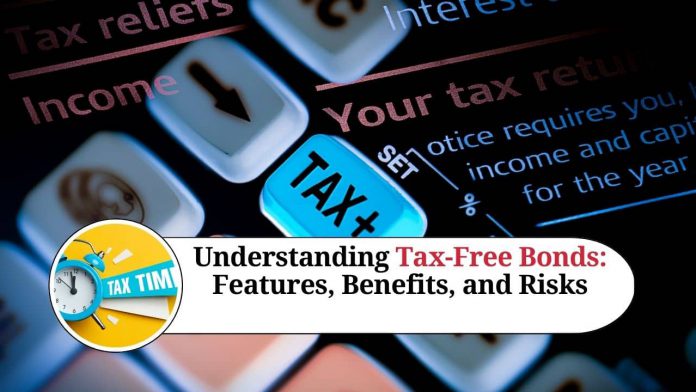Tax-Free Bonds: An Overview
Tax-free bonds are a type of fixed-income investment option issued by government-backed entities such as Public Sector Undertakings (PSUs) and infrastructure companies. As the name suggests, the interest income earned from these bonds is exempt from income tax. Tax-free bonds typically have a long tenure of 10-15 years and offer a fixed rate of interest to investors.
Advantages of Investing in Tax-Free Bonds
- Tax Exemption: The most significant advantage of investing in tax-free bonds is the tax exemption on interest income. This makes tax-free bonds an attractive investment option for investors in higher tax brackets.
- Low Default Risk: Tax-free bonds are issued by government-backed entities, which makes them a low-risk investment option. The probability of default is low, which means that investors are less likely to lose their principal amount.
- Regular Income: Tax-free bonds offer a fixed rate of interest to investors, which provides a regular source of income. This can be particularly beneficial for retirees or individuals who are looking for a steady income stream.
- Long Tenure: Tax-free bonds typically have a long tenure of 10-15 years, which means that investors can lock-in their investment at a fixed rate of interest for a long period.
Disadvantages of Investing in Tax-Free Bonds
- Low Liquidity: Tax-free bonds are not as liquid as other investment options such as stocks or mutual funds. If investors need to sell their bonds before maturity, they may have to do so at a lower price.
- Fixed Rate of Return: Tax-free bonds offer a fixed rate of return, which means that investors may miss out on higher returns if interest rates rise in the future.
- Inflation Risk: Since tax-free bonds offer a fixed rate of return, investors are exposed to inflation risk. If inflation rises, the purchasing power of the interest income may decrease.
How to Invest in Tax-Free Bonds
Investors can invest in tax-free bonds by purchasing them through a demat account or by applying for them in a physical form. The bonds are typically issued in tranches, and investors can apply for them during the issue period. The application process for tax-free bonds is similar to that of other debt instruments such as bonds and debentures.
The interest income from tax-free bonds is paid out on a semi-annual basis, and investors can choose to receive the interest either through direct credit to their bank accounts or by way of physical cheques.
Taxation on Tax-Free Bonds
As mentioned earlier, the interest income earned from tax-free bonds is exempt from income tax. However, if investors sell their bonds before maturity, they may be subject to capital gains tax. If the bonds are sold before one year from the date of purchase, the capital gains will be treated as short-term capital gains and will be taxed at the investor’s applicable tax rate. If the bonds are sold after one year, the capital gains will be treated as long-term capital gains, and will be taxed at a flat rate of 10% without indexation or 20% with indexation, whichever is lower.
Types of Tax-Free Bonds
Tax-free bonds are issued by various entities in India, including PSUs, infrastructure companies, and municipal corporations. Some of the popular tax-free bonds issued in India are:
- National Highways Authority of India (NHAI) Bonds: NHAI bonds are issued by the National Highways Authority of India, a government-backed entity that funds the development of national highways in India. These bonds offer a fixed rate of interest and have a long tenure of up to 15 years.
- Rural Electrification Corporation (REC) Bonds: REC bonds are issued by the Rural Electrification Corporation, a government-owned company that funds the development of rural electrification projects in India. These bonds offer a fixed rate of interest and have a long tenure of up to 20 years.
- Power Finance Corporation (PFC) Bonds: PFC bonds are issued by the Power Finance Corporation, a government-owned company that funds the development of power projects in India. These bonds offer a fixed rate of interest and have a long tenure of up to 15 years.
- Indian Railway Finance Corporation (IRFC) Bonds: IRFC bonds are issued by the Indian Railway Finance Corporation, a government-owned company that funds the development of railway infrastructure in India. These bonds offer a fixed rate of interest and have a long tenure of up to 15 years.
- Municipal Bonds: Municipal bonds are issued by municipal corporations to fund their infrastructure projects. These bonds offer a fixed rate of interest and have a relatively shorter tenure of up to 10 years.
Investors can choose to invest in these bonds based on their investment goals, risk appetite, and financial profile.
Conclusion
Tax-free bonds can be an attractive investment option for investors who are looking for a low-risk, tax-exempt source of income. However, investors should also be aware of the disadvantages of investing in tax-free bonds, such as low liquidity and the risk of inflation. As with any investment option, it’s important to consider one’s financial goals and risk tolerance before investing in tax-free bonds.
Read more useful content:
- How to Save Tax on Salary
- Guide to Understanding Direct Taxes in India
- Filing Income Tax Returns
- GST E-invoice
Frequently Asked Questions (FAQ’s)
Q1.) What are tax-free bonds?
Tax-free bonds are debt instruments issued by various entities, including PSUs, infrastructure companies, and municipal corporations. The interest income earned from these bonds is exempt from income tax.
Q2.) How are tax-free bonds different from other bonds?
Unlike other bonds, the interest income earned from tax-free bonds is exempt from income tax, making them an attractive investment option for investors looking for tax-free income.
Q3.) Are tax-free bonds risk-free?
No, tax-free bonds are not risk-free. While they offer a low default risk, there is still some degree of credit risk associated with these bonds.
Q4.) What is the minimum investment in tax-free bonds?
The minimum investment in tax-free bonds depends on the issuer and the specific issue. Some issuers may have a minimum investment requirement of Rs. 10,000, while others may have a higher minimum investment requirement.
Q5.) What is the tenure of tax-free bonds?
The tenure of tax-free bonds varies depending on the issuer and the specific issue. Some bonds have a tenure of up to 15 years, while others may have a longer tenure of up to 20 years.
Q6.) Can tax-free bonds be traded on stock exchanges?
Yes, tax-free bonds can be traded on stock exchanges, but they have low liquidity, which means that the trading volume may be low.
Q7.) Can NRIs invest in tax-free bonds?
Yes, NRIs can invest in tax-free bonds, subject to the rules and regulations set by the Reserve Bank of India (RBI) and the issuer.
Q8.) How is the interest income paid out on tax-free bonds?
The interest income on tax-free bonds is typically paid out on a semi-annual basis. Investors can choose to receive the interest either through direct credit to their bank accounts or by way of physical cheques.
Q9.) Can investors sell tax-free bonds before maturity?
Yes, investors can sell tax-free bonds before maturity. However, if the bonds are sold before one year from the date of purchase, the capital gains will be treated as short-term capital gains and will be taxed at the investor’s applicable tax rate.
Q10.) What is the tax treatment of capital gains on tax-free bonds?
If tax-free bonds are sold after one year from the date of purchase, the capital gains will be treated as long-term capital gains, and will be taxed at a flat rate of 10% without indexation or 20% with indexation, whichever is lower.




















